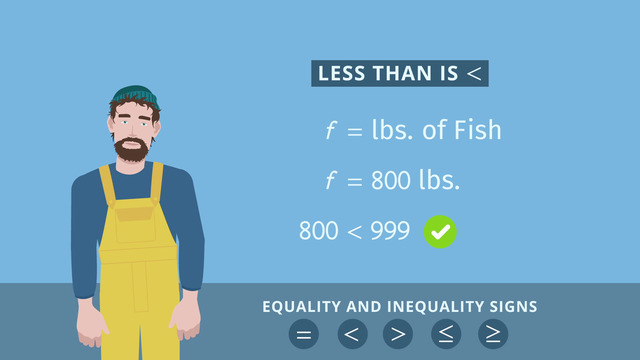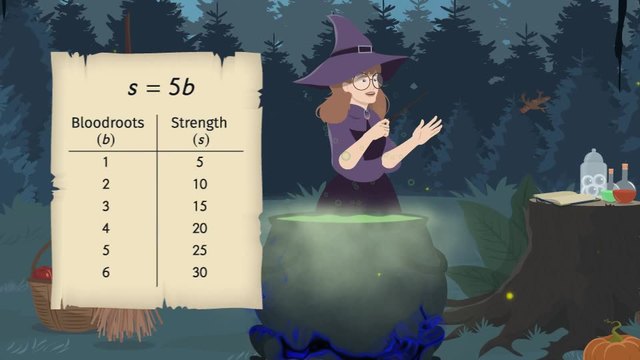From Equations to Inequalities


Basics on the topic From Equations to Inequalities
When two expressions are equal they form an equation. Two given expressions do not always have to be equal, however, and they can be compared against each other using inequalities. There are five major symbols that can be used to represent an inequality: the greater than, less than, greater than or equal to, less than or equal to, and not equal symbols. When the expression on the left side of the inequality has a greater value than on the right, then we use the greater than symbol. If it has a lesser value, then we’ll use the less than symbol. For example, 10 > 9 and 9 < 12. On the other hand, if the expression on the left side of the inequality is at least the value of the expression on the right, then we use greater than or equal to or if it is at most, then we use less than or equal to. And, of course, if the two expressions have different value, then we can simply use the not equal symbol. Learn more about inequalities by helping Wade protect the oceans’ fish population from overfishing. Common Core Reference: CCSS.MATH.CONTENT.6.EE.B.8
Transcript From Equations to Inequalities
Looks like fishing season has begun! Meet Wade. He's interested in protecting the fish population from overfishing, so they remain in our oceans forever. However, Wade's brother, Skeeter, earns a living from fishing, so he wants to catch as many as possible and hasn't bothered to learn the regulations. In order for Wade to help his brother understand the laws, he'll have to go from Equations to Inequalities. The fishing regulations state that each fisherman is allowed to catch exactly 999 lbs. of fish per month. So, let’s look at how many fish he caught in each of the last 3 months. Let's use the variable 'f' to represent the amount of fish Skeeter catches in pounds. In the first month, Skeeter caught 999 lbs. of fish. What symbol can we use to relate the amount of fish he caught with the legal limit? Out of all the signs and symbols available to us, we should use the equal sign. The numbers on either side of an equal sign have the same value. During the second month of his fishing trip, Skeeter caught 800 lbs. of fish. What symbol can we use to relate the numbers 800 and 999? We know that 800 is not the same as 999. This is no longer an equality, but an INequality. So we have to use a different symbol to relate these numbers. The symbol we use is called the less than symbol, since the smaller of the two numbers comes first. This is read as: 800 is less than 999. In Skeeter's third month of fishing, he caught a BIT more than 999 lbs. of fish...1250 lbs., to be exact. So, how do we relate how much fish Skeeter caught in month 3 with the fishing regulations of 999 lbs. of fish per month? If the number on the left is larger than the one on the right, we can relate the two numbers by using the greater than symbol. This symbol is similar to the less than symbol, but points in the opposite direction. Poor Skeeter, since he overfished in the 3rd month, he's gotta pay a fine! Now that we know the greater than and less than symbols, let's see if we can express, in math, the situations where Skeeter -- and the other fishermen -- will and won't have to pay a fine. Since catching under 999 lbs. of fish is okay, and there's nothing wrong with catching exactly 999 lbs. of fish, is there another sign we could use? In fact, there is! We can make a small addition to the greater than symbol, and it makes all the difference. If we combine the less than sign with an equal sign, we get something that looks like this. Now we have a mathematical sentence that correctly describes situations where fisherman will not have to pay a fine. Speaking of regulations, since catching 1,000 lbs. of fish or more is totally NOT okay, is there another sign we could use? You betcha! If we combine the greater than sign with an equal sign, we get something that looks like this. Now, we have mathematical sentences that correctly describe the fishing regulations. To describe each situation, we used different signs. The sign for equality is the equal sign. Use this sign if the two values are exactly the same, like 'x' is equal to 'y', or 999 is equal to 999. For an inequality, however, there are four different signs at our disposal. We use the 'less than' sign when the value on the left side of the inequality is smaller than the value on the right, like 800 is less than 999. We use the 'less than or equal to' sign if the value on the left side of the inequality is smaller or is the same as the value on the right side. 800 and 999 are both less than or equal to 999. We should use the 'greater than' sign when the value on the left side of the inequality is larger than the value on the right, like 1,250 is greater than 999. Finally, we use the 'greater than or equal to' sign if the value on the left side of the inequality is larger than the value on the right side, or is the same. Since 1,250 is at least equal to 1,000, we can use the greater than or equal to sign. Let's get back to Skeeter and see how many pounds of fish he caught today. Huh?! Have you ever seen that species of fish before?
From Equations to Inequalities exercise
-
Compare the amount of fishes Skeeter fished with the catching limit of $999$ lbs. per month.
HintsLet's look at the following examples:
- $12>10$, where $>$ is the greater than sign.
- $10<12$, where $<$ is the less than sign.
You can compare an equation with a scale: for equality, on both sides of the equals sign we must have the same value. So a scale would be in balance.
SolutionThe fisherman, Skeeter, has to take care of a very important regulation: the amount of fishes he is able to catch is limited to $999$ lbs. a month.
In the first month, Skeeter caught exactly $999$ lbs. That's the same as the given limit. So we use the equals sign:
$999=999$.
The value on the left side is equal to the one on the right side.
The second month, he caught $800$ lbs. of fishes. This is less than the allowed amount. Thus we use the less than sign:
$800<999$.
The value on the left side is smaller than the one on the right side.
In the third month, Skeeter caught $1250$ lbs of fish. Oh, that's illegal. It's more than the allowed amount. Here we use the greater than sign:
$1250>999$.
The value on the left side is greater than the one on the right side.
-
Express the given problem exactly.
HintsThe less than sign $<$ indicates that the value on the left side of the sign is less than the one on the right side.
For example, $10<12$.
But $=$ is not included.
If we include $=$ with $<$ sign, we write it as $\le$.
So, for example, we have that $12\le 12$.
SolutionPlease help Skeeter to find out the correct expression which represents the allowed amount of lbs. of fishes which can be caught per month.
He already knows that $800$ lbs. is OK, and that $999$ lbs. is allowed too.
That means that the regulation is fulfilled for amounts less than $999$ lbs. and also for $999$ lbs. itself.
We can express these regulations using the less than or equal to sign $\le$.
If $f$ the amount of lbs. of fishes caught by Skeeter in a month, then if $f$ is less than or equal to $999$ the regulations are followed:
$f\le 999$.
-
Find the mistakes.
HintsKeep the following in mind:
If you use the equals sign, $=$ , the numbers on both sides of the sign must be the same.
Let's have a look at the following examples:
- $23=23$
- $23\le 23$
- $23\ge 23$
- $22 < 23$
- $22\le 23$
- $22>21$
- $22\ge 21$
The following sentences aren't true:
- $23>23$
- $22<21$
- $21>22$
- $21=22$
Keep the following in mind: if two numbers are equal, you can also use $\le$ as well as $\ge$ because both include the equals sign.
SolutionThe relation signs express if two numbers are equal, or if one is greater or less than the each other.
Here you see some examples for the equal sign:
- $234=234$
- $123=123$
- $345=345$
- $234\le234$ as well as $234\ge234$
- $123\le123$ as well as $123\ge123$
- $345\le345$ as well as $345\ge345$
Last we still have,
- $789<890$ or $789\le 890$
- $890>123$ or $890\ge 123$
-
Find the right expression.
HintsPay attention to if equality is allowed or not.
Let's have a look at an example: if Paul is only allowed to eat $4$ tacos then he can eat no tacos at all, or just one, two, three, or four tacos. We can write this as follows, using $t$ for the number of tacos: $t\le 4$.
SolutionSpeed limit:
A race of $60$ mph or less is allowed. So we can use $\le$ with the variable $s$ for the speed: $s\le 60$.
Alcohol:
From $21$ years or older means that alcohol is allowed to be bought by those who are $21$ years or older than $21$. Mathematically we can write it like this as $y\ge 21$, where $y$ is the number of years.
Duty free:
Here we have an upper bound of $200$ dollars. Let $a$ be the variable for the amount. Then we have that $a\le 200$.
-
Recall the definitions of the mathematical relation signs.
Hints$999=999$
This is an example for the $=$ sign.
- $800<999$
- $999\not < 999$
- $800\le 999$
- $999\le 999$
- $1250>999$
- $999\not > 999$
- $1250\ge 999$
- $999\ge 999$
SolutionHere you see the summary for all relation signs:
$=$ stands for is equal to. For example, $999=999$.
$<$ stands for is less than. For example, $800<999$.
$\le$ stands for is less than or equal to. For example, $800\le 999$ as well as $999\le 999$.
$>$ stands for is greater than. For example, $1250>999$.
$\ge$ stands for is greater than or equal to. For example, $1250\ge 999$ and also $999\ge 999$.
-
Explain the expression.
HintsPay attention to $8<x$; $8$ is not included.
$8<x\le9$ stands for
- $8<x$ and
- $x\le 9$.
For example, $10$ is greater than $8$, but $10$ isn't less than or equal to $9$.
So $10$ am isn't a possible arriving time.
All times less than or equal $8$ am aren't possible arriving times.
All times greater than $9$ aren't possible arriving times.
SolutionPoor, Mia. Skeeter is so enthusiastic about inequalities. Thus, she get's the time she should arrive as an inequality. Let $x$ be the time she arrives:
$8<x\le 9$.
What does this mean?
Let's start with the left side: $8$ am.
- Mia should not arrive before $8$ am.
- She also should not arrive at $8$ am because $8$ am is not included. You can recognize this by the $<$ sign.
- Mia should not arrive later than $9$ am.
- $9$ am itself is a possible arriving time.
- $8:01$ am
- $8:02$ am
- ...
- $8:30$ am
- ...
- $8:59$ am and
- $9:00$ am













